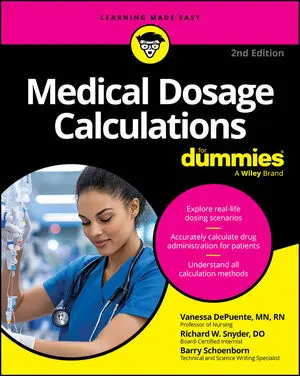This builtin is not currently supported: Animation
- Book & Article Categories

- Collections

- Custom Solutions
 Main Menu
Main MenuBook & Article Categories
 Main Menu
Main MenuBook & Article Categories
Barry Schoenborn
Barry Schoenborn, a longtime math, science, and technical writer, is the coauthor of Technical Math For Dummies, Medical Dosage Calculations For Dummies, and Physician Assistant Exam For Dummies.
Articles & Books From Barry Schoenborn
An accurate and easy-to-read resource for students in medical dosage calculation classes Medical Dosage Calculations For Dummies, 2nd Edition is an accurate guide to dosage calculation that tracks to standard course curricula. It's an easy-to-follow supplementary resource for students of nursing, pharmacology, paramedic programs and beyond, walking you through ratio-proportion, formula, and dimensional analyses for a wide variety of medication types.
Article / Updated 06-20-2023
A lot of pathology and Physician Assistant Exam questions concern the small and large intestines. Here you see conditions such as irritable bowel syndrome (IBS), ischemic bowel, inflammatory bowel disease (IBD), celiac disease, and diverticulitis.
Irritable bowel syndrome (IBS)
Irritable bowel syndrome (IBS) is a diagnosis of exclusion after other conditions have been ruled out.
Cheat Sheet / Updated 04-27-2022
Grasping some technical math basics can simplify everyday situations faced by many professionals and even non-professionals, including having to solve word problems, calculate tips, make change, or match American and metric measurements.Simple steps for solving word problemsWord problems aren’t just on school tests.
Cheat Sheet / Updated 04-13-2022
When you're preparing to take the PANCE or PANRE, you may feel like you have to know an endless amount of information. How will you ever remember all the details of so many diseases and conditions? Here, you can review some useful mnemonics that will not only help your recall as you prepare for your physician assistant exam but also improve your clinical acumen.
Cheat Sheet / Updated 02-28-2022
Using real-life math can simplify everyday situations. Math comes in handy every time you take a trip, go shopping, or do projects around the house.Estimating taxes and discounts when shoppingWhen you go shopping, you often encounter discounts and sales offers that change the price of an item. In addition, many states in the United States charge sales tax, and if you’re shopping abroad, you may face a value added tax.
Cheat Sheet / Updated 01-20-2022
No matter what initials you have after your name (RN, CNA, PA, and so on), you can bet you’ll see math on a daily basis if you’re going into (or are already in) a career in the medical field.Grasping some medical math basics — such as how to break down medical dosage problems into steps and use conversion factors — can simplify everyday situations all health care professionals face.
Article / Updated 05-13-2016
A common scenario you deal with clinically and for the Physician Assistant Exam (PANCE) is inadvertently finding a lung lesion on a chest radiograph. You’re looking for something, and bam! There it is. What do you do about it? You assess the lesion on the radiograph:
Check the other lung findings to make sure that you’re just dealing with a pulmonary nodule.
Article / Updated 04-25-2016
Many household projects require that you be able to calculate area or volume. Whether you're painting your kid's room, mulching your flowerbed for the winter, planting grass seed in the spring, or tackling any other project for which you need to find out how much of something you need to cover, knowing how to figure area and volume is a time- and money-saver.
Article / Updated 03-26-2016
Word problems aren’t just on school tests. You solve word problems every day in your work or even while you’re just out and about. Don’t worry — these steps make solving word problems easier than you think. Just follow these easy steps to take away the mystery:
Read the problem.
Begin by reading the problem carefully.
Article / Updated 03-26-2016
If you’ve ever had to match American and metric measurement units, you know direct comparisons of these unit systems can be tricky. If you need to know the metric equivalent of an inch, for example, or the American equivalent of a kilometer, use the following table to help you make a proper comparison between the two systems of measurement.




